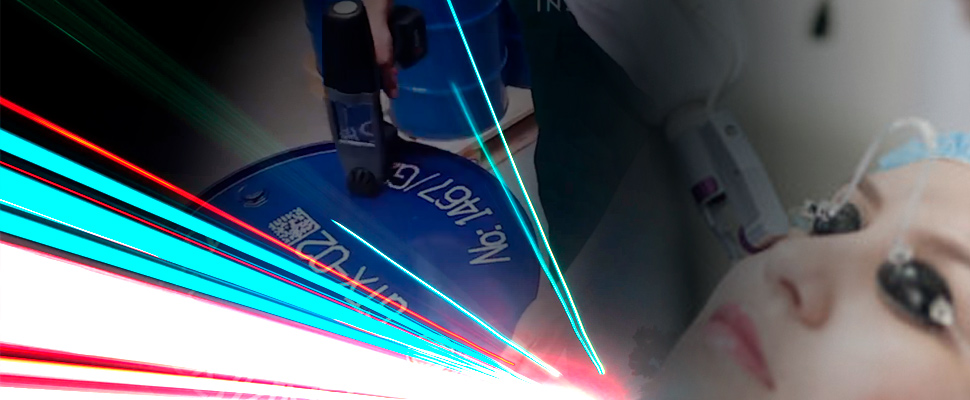How laser revolutionized the technology of everyday objects
Listen to this article
The perfection of the laser has evolved widely diverse fields such as health and industry making them more effective, faster and less invasive

First of all, laser, according to its initials, means 'light amplified by stimulated emission of radiation'. With this it refers to a concentrated and direct light that can vary its intensity depending on the use that is going to be given, according to La Razón. The main advantages offered by laser are that clinical treatments are usually less painful, since there is no need to use anesthesia and bleeding is nil in most cases. Despite this, the results are the same or better than the use of other tools such as the scalpel.
Leer en español: ¿Cómo el láser revolucionó la tecnología de los objetos cotidianos?
Laser and technology
Perhaps one of the devices most affected by the laser revolution was the printers. Already HP presented in previous years laser printers that generate a higher yield than ink; with an impression of 47 pages per minute, its duration is longer and the results more accurate. Although this advance has gone under the table, the application of the laser in a device as common as the printer has facilitated office work, making them faster.
Similarly, although laser printers are usually more expensive, the duration of the ink is longer, so costs can be reduced. In addition, the laser goes beyond simple printers of homes, since according to Technology Area, there are 3D printers that work with laser, with which physical objects are manufactured through plans programmed in computers, from clinical prostheses to everyday objects , another more benefit of the laser.
Impresora láser portátil capaz de imprimir sobre cualquier superficie pic.twitter.com/L0MLoIRDcs
— AgroSprint (@AgroSprint) 23 de mayo de 2018
Likewise, according to InformeTICPlus, other devices that take advantage of the laser are the bar code reader, which facilitated the speed of sales and records, and CD and DVD discs, which are read by laser technology. As for optical fiber, the laser participates in its operation, which is why it is the fastest and most stable means of telecommunications and for which, at the time, it meant an important advance in the communication sector. In each of these, the laser allowed to reduce the waiting time and minimize the use of other tools such as video cassettes and improve their functions, such as a better image.
You may be interested: Smart Wall: an "economic" alternative for Trump
Health
The area most benefited by the laser is health. Whether for aesthetics or comprehensive health, the laser has allowed the performance of non-invasive surgeries, that is, in some cases it is no longer necessary to cut the skin- Sanitas reports that currently the laser is used for aesthetic surgeries, eliminating varicose veins, stretch marks , spots, moles and even tattoos.
On the other hand, it is possible to suppress cataracts or reduce myopia, astigmatism among other ophthalmological conditions. This breakthrough has allowed more people to accept and come to have the necessary medical treatments to take care of their health, since before they feared the use of anesthesia, cuts in the skin, stitches and careful post-operation treatment.
Momento en el que el laser realiza los pasos mas cruciales de la cirugía #martes #cirugias #catarata #lenSx #Dyter pic.twitter.com/ICfXADS5pw
— Pedro Miranda (@DrMirandaPedro) 26 de enero de 2016
The field of dermatology is the one that makes the most use of the laser, since, according to 20 Minutes, surgeries to remove precancerous lesions also use laser devices. In aesthetic uses, there is laser hair removal, which is more durable and can completely eliminate the growth of most black hair. So dermatology and aesthetics has simplified its application and reduced the use of needles and other more painful tools.
Sin palabras. Os dejamos con otro resultado excepcional tras 1 sesión de tratamiento con la infalible luz pulsada AFT-Dye de Alma. ¿Aún no sabías por qué esta tecnología es única?
¡Contacta con nosotros hoy mismo!
https://t.co/h5MGNK87kE
https://t.co/yPBM5aPFNu pic.twitter.com/9aaYeoQq6Q— Alma Lasers Médica (@AlmaLasersMedic) 15 de mayo de 2019
Beyond surgeries, the laser is effective in treatments for therapeutic purposes to relieve pain and regenerate cells, since according to Vital Clinic, a certain type of laser can deeply penetrate the body's tissues, improving blood circulation and thus decrease inflammation and pain. It also ensures rapid recovery, due to the regeneration of damaged cells. This can be used for the treatment of herniated discs and lumbago, tendinosis, jaw pain and more.
Industries
Ejecutamos cortes en acero inoxidable con precisión 0,03mm/m #corte #laser #metalurgia #chapa #acero pic.twitter.com/dsf86nvNot
— MYT Soluciones (@MYTsoluciones) 24 de septiembre de 2018
Large industries have also taken advantage of the benefits of the laser. For example, they are used to cut and engrave materials such as glass and metals. According to the blog Perez Camps, a company specializing in the sale of machinery for laser cutting and engraving, the latest generation lasers allow increasingly thick metal cuts, leaving precise finishes and no carbon remains regardless of the shape of the cut. In addition, it has more power, but with lower energy consumption, being a productive alternative for companies.
With this, the industries have improved their production in terms of speed and quality of results and, although laser tools are expensive and need water to regulate the temperature, the use-duration ratio allows a shorter working time than with other machines.
As for glass, TrotecLaser notes that it is possible to use machines that use lasers to design an engraving in various materials such as glass and ceramics, making it possible to capture photographic images, logos and other fine designs with matt marks. This use is common in bottles of alcoholic beverages such as wines and champagnes.
LatinAmerican Post | Juan Bacallado
Translated from "¿Cómo el láser revolucionó la tecnología de los objetos cotidianos?"





